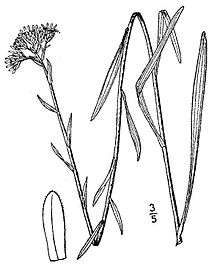Oligoneuron houghtonii
| Oligoneuron houghtonii | |
|---|---|
 | |
| 1913 illustration[1] | |
| Scientific classification | |
| Kingdom: | Plantae |
| (unranked): | Angiosperms |
| (unranked): | Eudicots |
| (unranked): | Asterids |
| Order: | Asterales |
| Family: | Asteraceae |
| Tribe: | Astereae |
| Genus: | Oligoneuron |
| Species: | O. houghtonii |
| Binomial name | |
| Oligoneuron houghtonii (Torr. & A.Gray ex A.Gray) G.L.Nesom | |
| Synonyms[2] | |
| |
Oligoneuron houghtonii is a rare North American species of flowering plant in the aster family known by the common name Houghton's goldenrod. It is native to southern Ontario in Canada and also the northern United States (Michigan and New York).[3] It is threatened by the loss and degradation of its habitat. It is a federally listed threatened species of the United States and it is designated a species of special concern by Canada's COSEWIC.[4]
Oligoneuron houghtonii is a perennial herb producing one or more erect stems up to 60 centimeters (2 feet) tall or more from a branching caudex covered with the remains of previous seasons' leaves. The leaves near the base of the plant are oval in shape and those higher on the stem are linear or lance-shaped and up to 17 or 18 centimeters (6.8-7.2 inches) in length. The inflorescence is an array of many flower heads each up to a centimeter long. The head contains 6 to 12 yellow ray florets surrounding several disc florets. The fruit is about half a centimeter (0.2 inches) long including the pappus of bristles at the tip.[5] Blooming occurs in August.[4]
Oligoneuron houghtonii grows on the shores of the Great Lakes, mainly Lake Huron and Lake Michigan, near the Michigan-Ontario border at Sault Ste. Marie. [5] It grows in sandy lakeshore habitat types as well as moist limestone alvars. The habitat is sometimes submerged but the plants return when water levels drop.[6] It also occurs in bog habitat.[4]
Oligoneuron houghtonii is threatened by the loss, degradation and fragmentation of its habitat during development and construction. Any disturbance of the dunes among which the plant grows can be harmful. The use of off-road vehicles in the habitat is detrimental, and the installation of walls, roads, and other structures affects the dunes. Maintenance activities such as herbicide application, mowing, and road salting are threats, as is beach recreation.[4]
Since 1975 about 20% of the populations of this plant have been eliminated.[4]
References
- ↑ illustration from USDA-NRCS PLANTS Database / Britton, N.L., and A. Brown. 1913. Illustrated flora of the northern states and Canada. Vol. 3: 398.
- ↑ The Plant List, Solidago houghtonii Torr. & A.Gray
- ↑ Biota of North America Program 2014 county distribution map
- 1 2 3 4 5 Oligoneuron houghtonii. The Nature Conservancy.
- 1 2 Oligoneuron houghtonii. Flora of North America.
- ↑ Oligoneuron houghtonii. Center for Plant Conservation.
